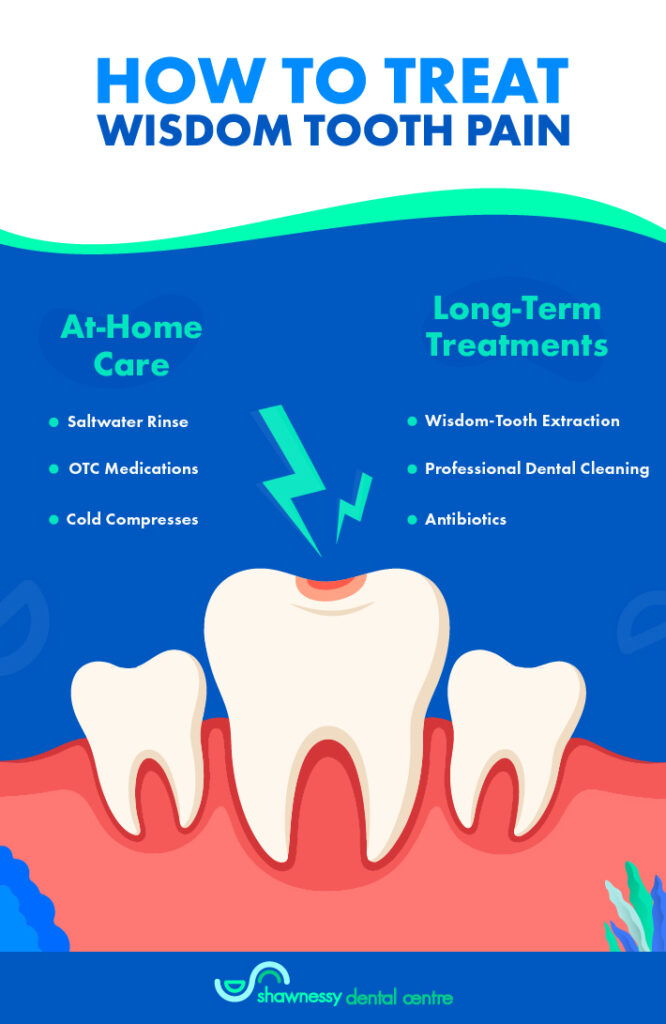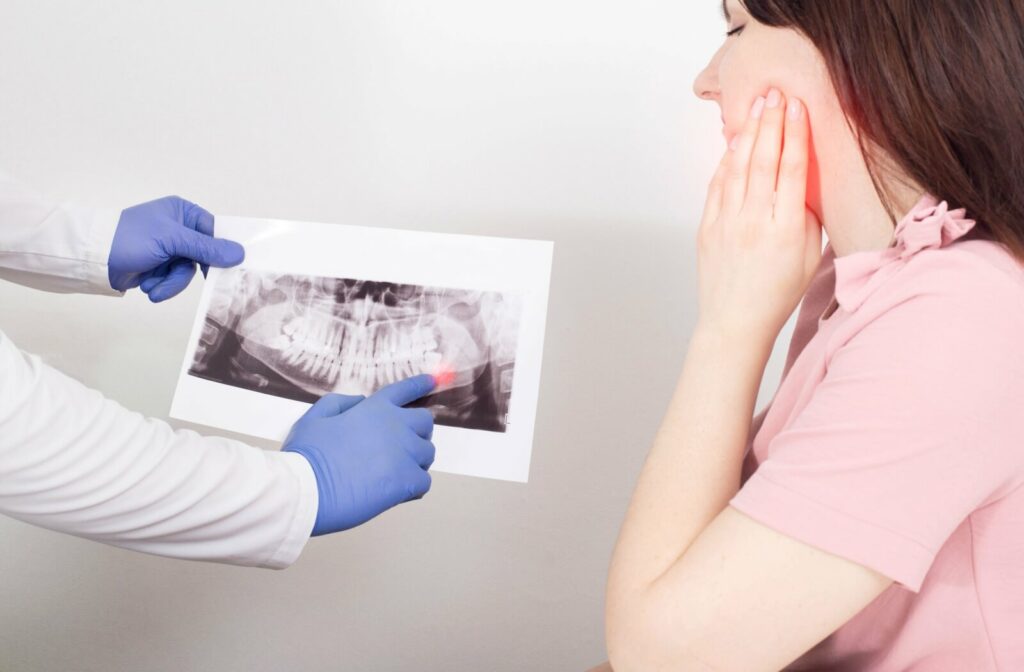Wisdom teeth—for some, they’re a minor inconvenience, while for others, they can cause unbearable pain. These third molars tend to make an appearance between the ages of 17 and 21, but not everyone’s mouth has room for them to grow. The result? Impacted wisdom teeth, gum irritation, and other causes of discomfort or pain.
If your wisdom teeth don’t require removal, you may be able to manage the pain with simple at-home remedies. However, if extraction is necessary, professional treatment might be the most effective solution. Pain relief options range from saltwater rinses and over-the-counter pain relievers to seeking care from your dentist.
What Causes Wisdom Tooth Pain?
Wisdom tooth pain is commonly caused by impacted wisdom teeth, inflammation, or other oral health concerns. Understanding the root cause of your pain is the first step to relief.
Impacted Wisdom Teeth
When wisdom teeth don’t have enough room to fully erupt, they often become “impacted,” meaning they’re stuck below the gums or growing at an angle. This can put pressure on nearby teeth or even cause jaw pain.
Inflammation & Swelling
A partially erupted wisdom tooth can leave gum tissue around it irritated or swollen, making it painful to chew or even talk.
If you’ve already had your wisdom teeth removed, you might notice some swelling, as it’s a natural part of the healing process. When the tooth is extracted, the body responds to the procedure as a minor injury. This triggers an inflammatory response to promote healing.
Gum Disease (Pericoronitis)
Food particles and bacteria can accumulate around the wisdom tooth, leading to gum infections like pericoronitis. This infection can worsen wisdom tooth pain and even lead to bad breath or a foul taste in the mouth.
Tooth Decay & Cavities
Because wisdom teeth can be hard to clean, they’re more prone to cavities. Common indicators include persistent tooth sensitivity to hot, cold, or sugary foods, as well as lingering pain that doesn’t subside over time. You may also notice visible holes or dark spots on neighbouring teeth, which could signal decay.
Immediate Relief Methods
Dealing with wisdom tooth pain can be frustrating, but there are a few simple remedies you can try at home to ease the discomfort.
These methods are designed to provide temporary relief by soothing inflammation and numbing the affected area. While they typically won’t eliminate the underlying issue, they can help self-treat wisdom tooth pain temporarily until you see a dentist.
Saltwater Rinse
Mix half a teaspoon of salt into a cup of warm water and swish it around in your mouth for 30 seconds. This rinse helps clean the area, and reduces inflammation.
Over-the-Counter (OTC) Pain Relievers
Using OTC medications such as ibuprofen or acetaminophen can help you manage mild to moderate pain.
Cold Compress
For swelling, apply an ice pack wrapped in a towel to the outside of your cheek for 15 minutes at a time. The coldness helps numb the area, reduce inflammation, and ease throbbing discomfort.

Long-Term Solutions
While immediate relief helps you manage the problem day to day, addressing the root cause requires professional guidance.
Extraction
Removing the problematic wisdom tooth is often the best way to permanently eliminate discomfort, especially in cases of impaction or recurring infections. Wisdom tooth extraction is a standard procedure that can resolve the issue for good.
Dental Exams
A follow-up checkup after a wisdom tooth extraction is essential to promote proper healing and to rule out complications like an infection, dry socket, or improper alignment of neighbouring teeth. Your dentist can assess the healing process, address lingering discomfort, and provide guidance for maintaining your oral health after the procedure.
Professional Cleaning
Sometimes, professionally cleaning the gum area around partially erupted wisdom teeth can decrease irritation and inflammation. Your dentist or hygienist can use special instruments to clean the gum area and remove any plaque or bacteria buildup.
Antibiotics
If you’re diagnosed with an infection such as pericoronitis, your dentist may prescribe antibiotics to clear it up before proceeding with further treatments.
Antibiotics could also be necessary after a wisdom tooth extraction to prevent or treat infections. While the procedure is performed under sterile conditions, the mouth naturally contains bacteria, which can sometimes lead to infections at the extraction site. They are particularly recommended if you have a compromised immune system or if the extraction was complex, such as in cases involving impacted teeth.
Pain Prevention Tips
To prevent wisdom tooth pain after an extraction, follow your dental surgeon’s instructions closely. They’ll likely advise you to be gentle with the extraction site, along with these tips:
- Practice good oral hygiene: Keep your teeth and gums healthy with daily brushing and flossing. Use a soft-bristle toothbrush to brush your teeth, and consider an antimicrobial mouthwash to reduce bacteria.
- Stay ahead of gum disease: Schedule regular checkups and cleanings with your dentist to prevent gum disease and keep your oral health in check.
- Address pain early: If you notice persistent pain, don’t wait until it worsens. You may be able to prevent larger problems down the road by addressing it early.

When to See a Dentist
Sometimes, wisdom tooth pain can’t be resolved with self-care. Contact your dentist immediately if you experience any of the following signs:
- Severe pain that interferes with your daily activities
- Persistent swelling or difficulty opening your mouth
- Signs of infection, such as fever, pus, or foul-tasting discharge
- Pain that hasn’t improved after a few days of self-treatment
Talk to the Professionals at Shawnessy Dental Centre
Wisdom tooth pain can be frustrating, but relief is within reach. Removing problematic wisdom teeth can significantly alleviate pain and prevent future complications.
Extraction helps address issues such as overcrowding, infections, and pressure on neighbouring teeth, allowing you to maintain a healthier and more comfortable smile. By tackling these problems early, you can avoid prolonged discomfort and protect your overall oral health.If your discomfort persists or worsens, don’t wait. Book an appointment at Shawnessy Dental Centre today to learn how we can help.


